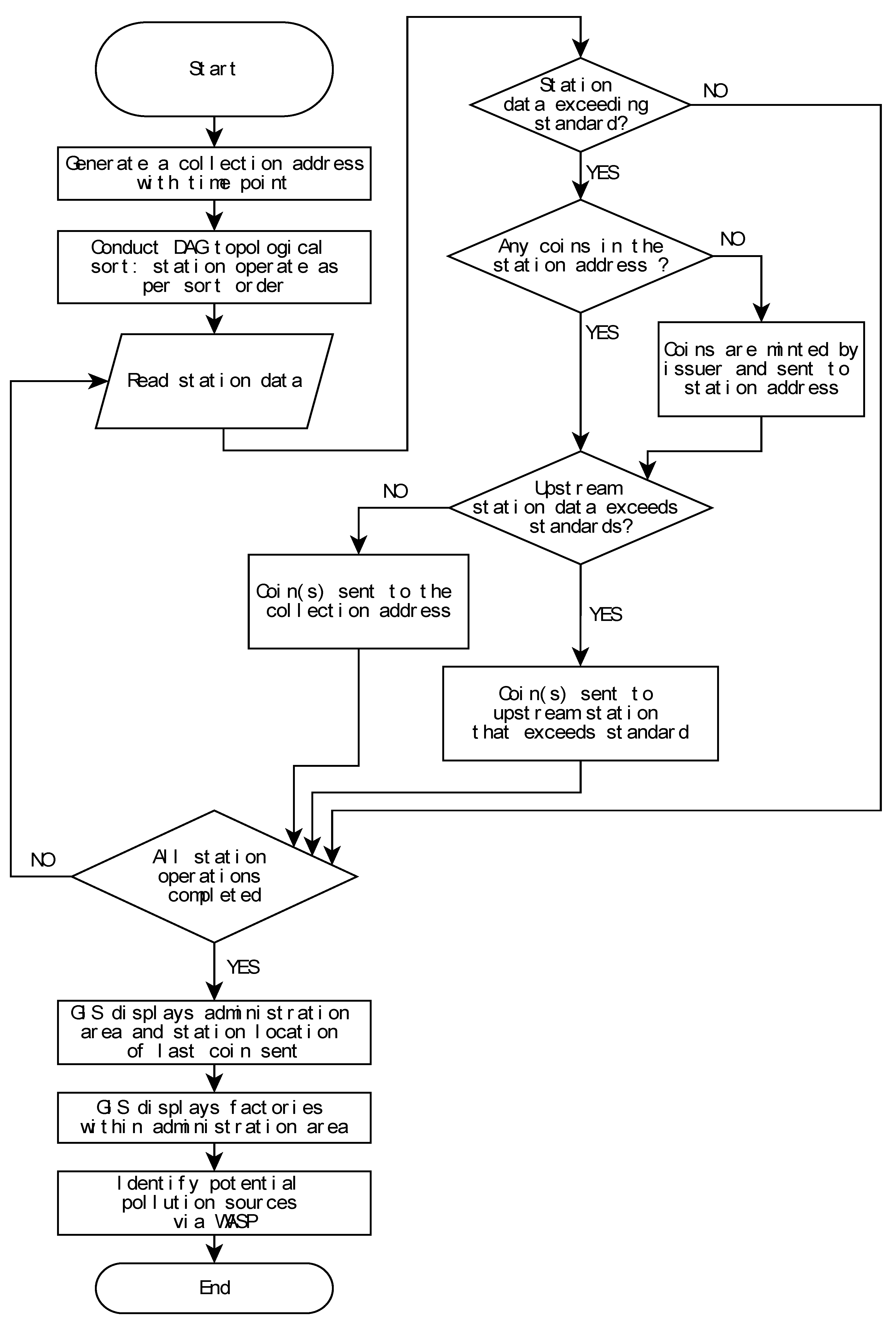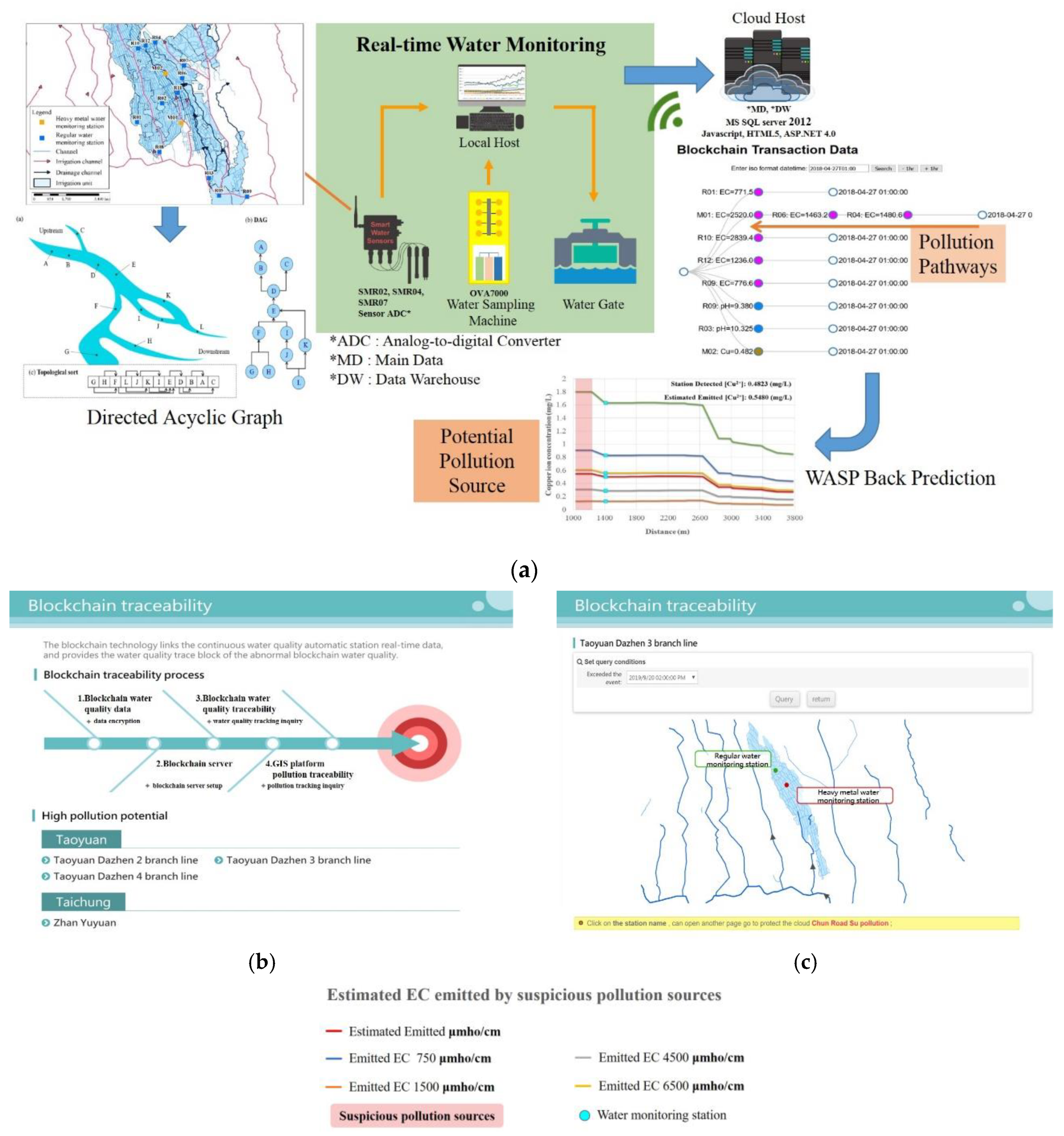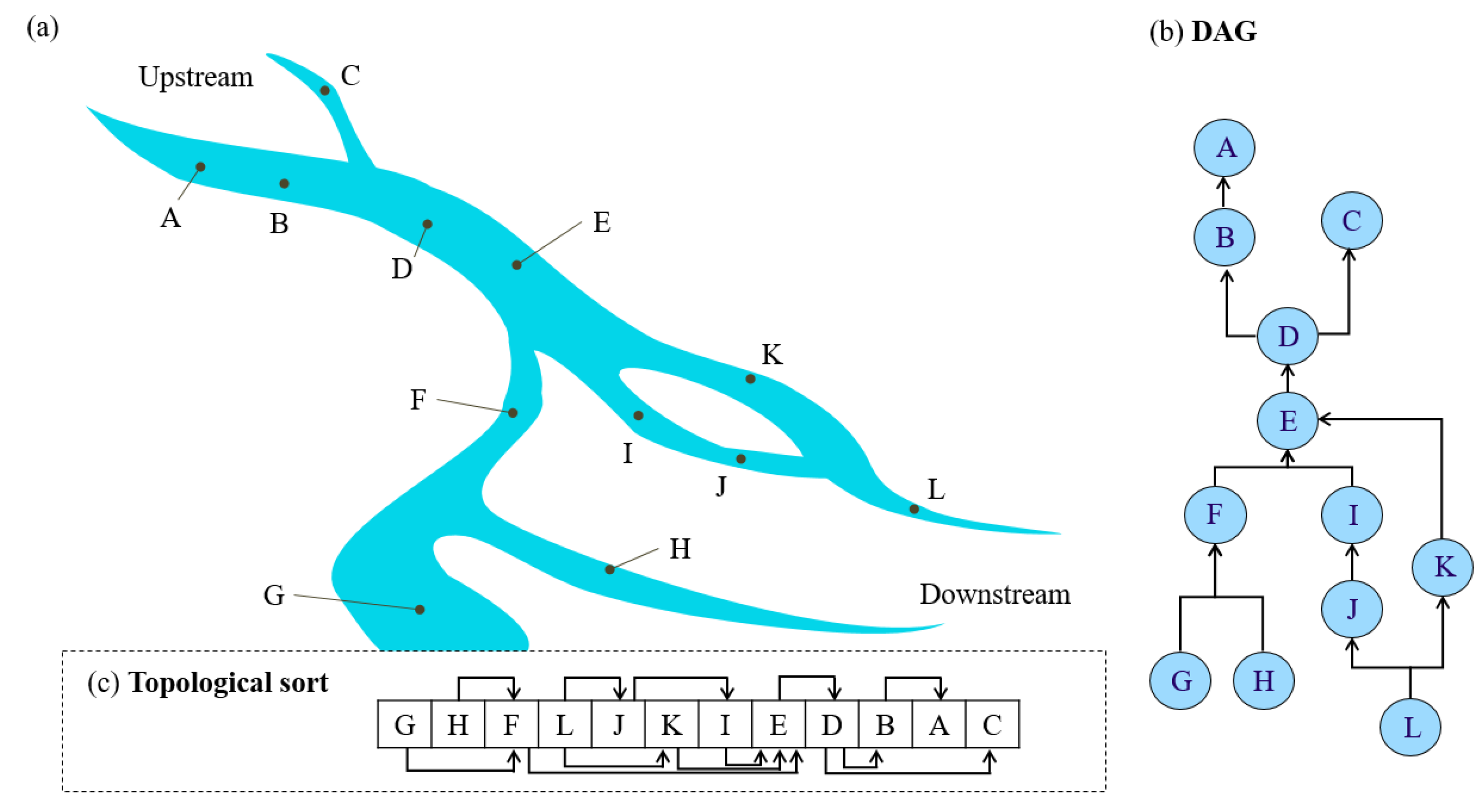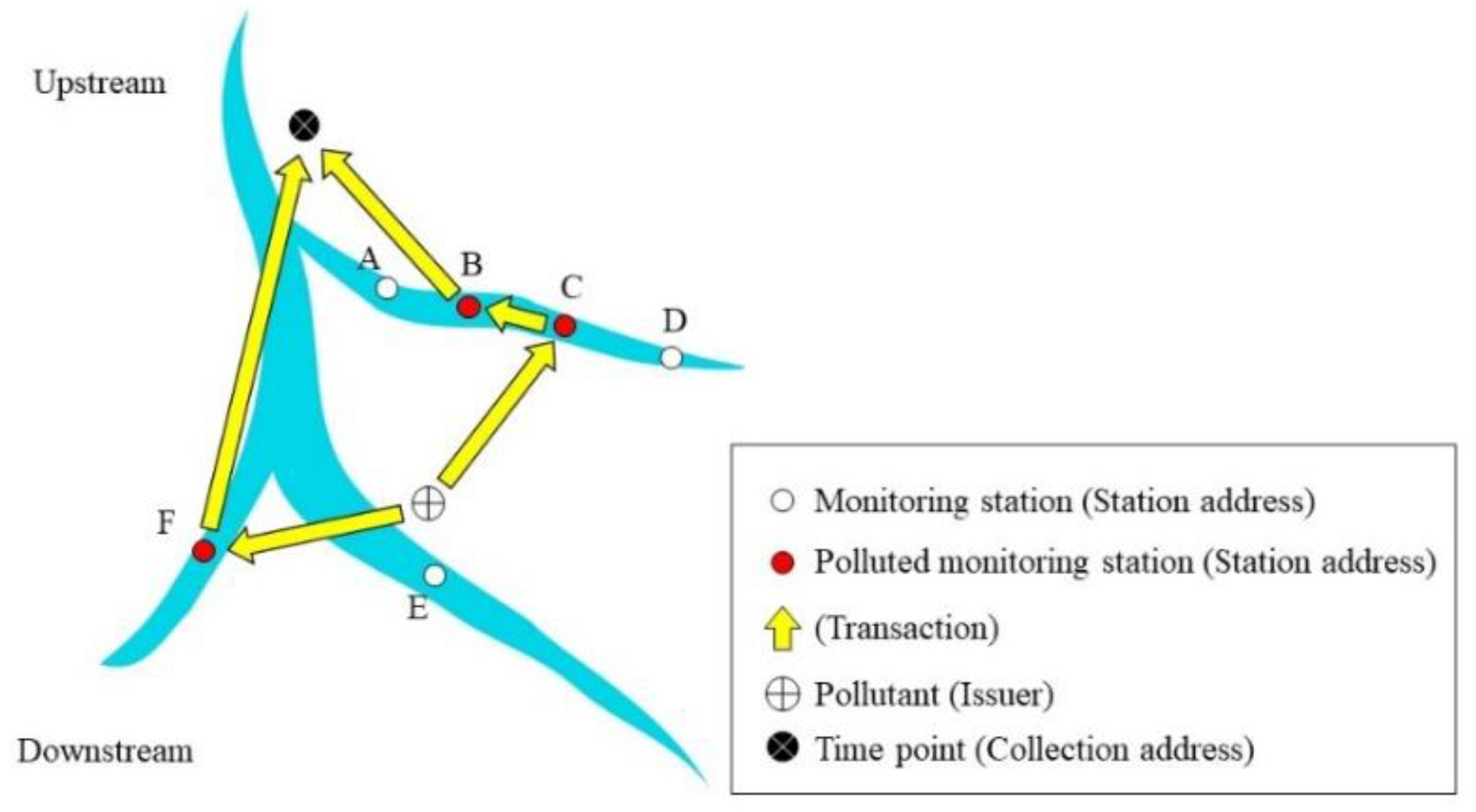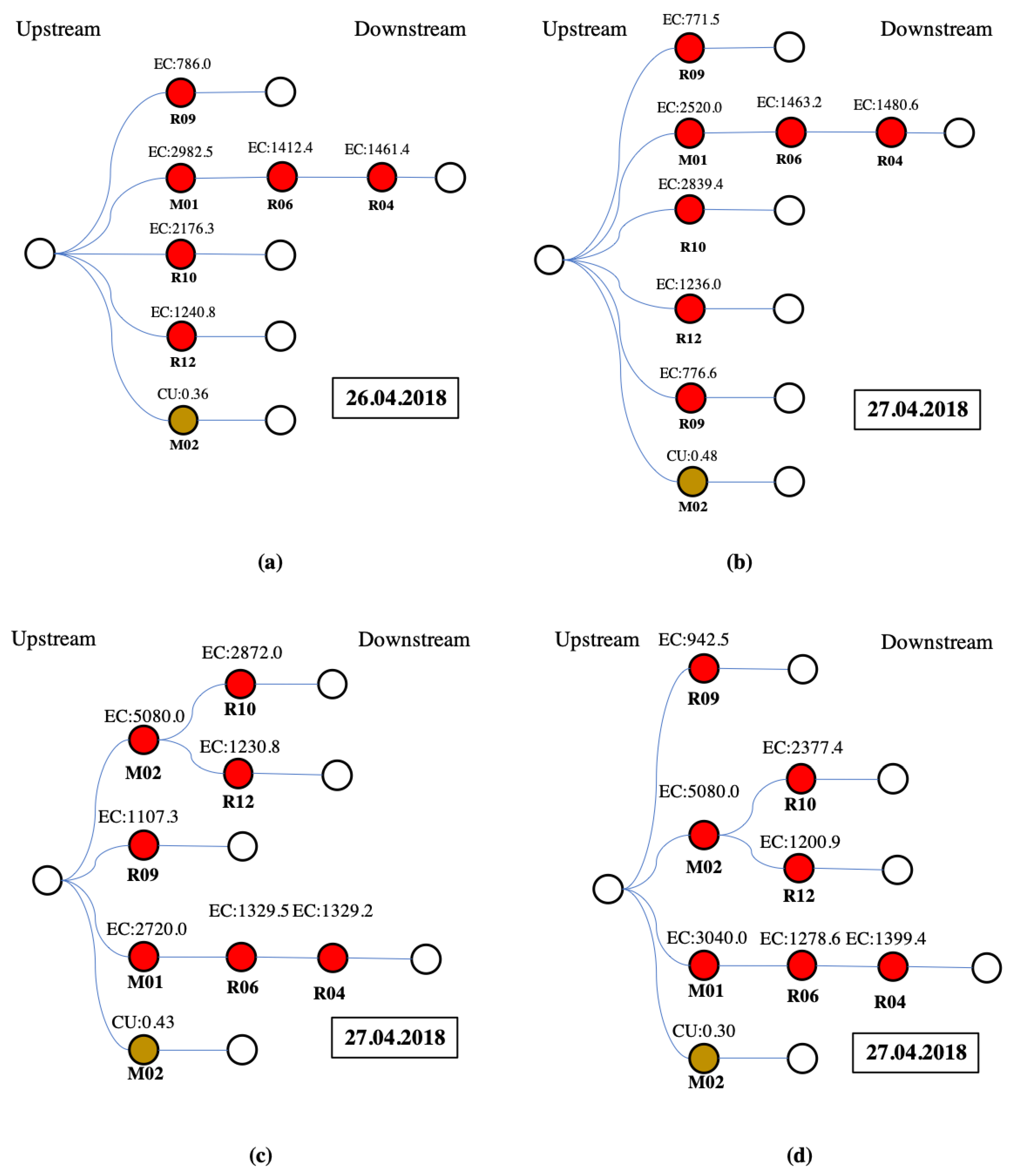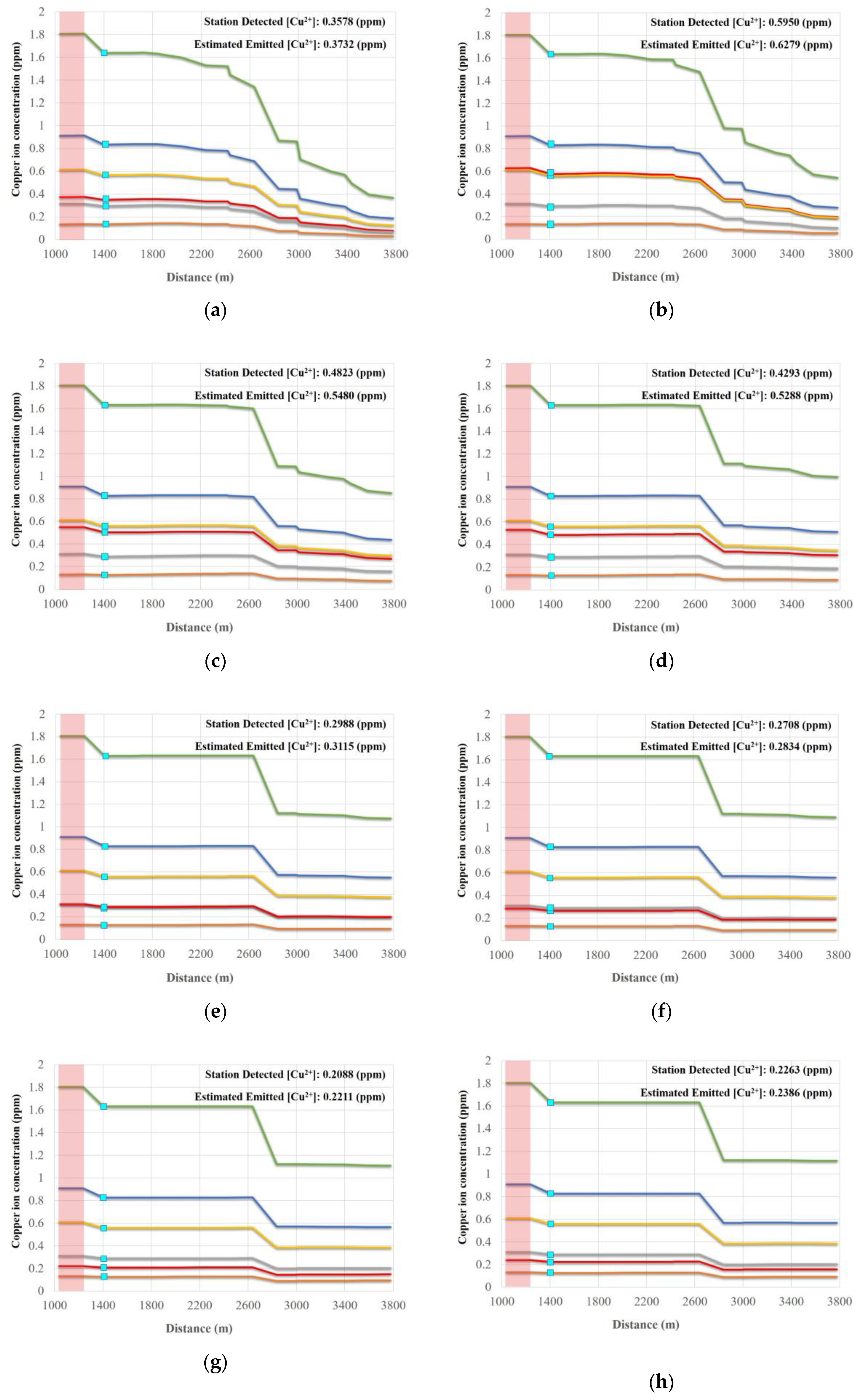1. Introduction
Illegal wastewater discharge due to rapid industrialization has resulted in heavy metal contamination in farmlands via irrigation channels. It is a severe threat to the environment, agricultural production, and public health [
1,
2,
3]. Although rapid identification of irrigation water pollution sources and pathways (PSP) is key to managing irrigation water quality for agricultural production, it is an extremely difficult task in agricultural areas that are located within industrialized areas [
4,
5,
6]. A real-time water quality monitoring network can collect water quality information at set (or at network) locations in real-time (or at regular intervals) and can provide monitoring data for both current status analysis and water quality trend forecasts. Potential pollution sources can then be identified [
7,
8], enabling the emergency disposal of pollutants in contaminated areas [
9]. Moreover, a system that allows PSP tracing is essential to providing authorities with real-time documentation that narrows the scope of likely pollution sources for rapid identification and isolation of irrigation water pollution and pathways; and for protecting agricultural production environments. Furthermore, real-time identification and isolation of PSP are necessary for water quality management and control actions [
6,
8]. Pollution event data should be secured for further actions such as tracing and recording PSP without risk of data tampering.
Recently, blockchain technology has been widely utilized in many fields such as healthcare for medical data [
10,
11]; food production tracing [
12,
13]; and has been proposed for application to irrigation water resource management [
6,
14]. Blockchain technology provides significant security advantages such as user authentication through public keys and digital fingerprints, data immutability, and transaction transparency with traceability characteristics [
15,
16]. Since all transactions use hash functions and use hash values as fingerprints, a blockchain ensures that data cannot be changed. Critical information storage (e.g., pollution event data) and transactions can be delegated to the blockchain, while endpoint devices or platforms can remain ‘dumb’, untrusted, and require very little maintenance [
17]. Blockchain technology’s robust consensus-based security architecture that does not require a central certifying authority also renders it particularly suitable for the authentication of ownership rights [
17,
18]. Accordingly, blockchain transaction records can reference uploaded and secured data [
19,
20]. Currently, the two most used blockchain transaction models are the unspent transaction output (UTXO) model and the account-based model. Just as blockchain technology used with Internet of Things (IoT) technology provides a way to trace a product’s lifecycle from raw materials used, to end production [
21]; these technologies can be used to trace a pollution event from the pollution source, through its pathways, to the polluted area. Blockchain technology used with IoT and sensor networks, however, can potentially identify PSP. Moreover, pollution event data can be secured by blockchain technology.
Integrating effective real-time tools with real-time water quality monitoring data can improve the identification of irrigation PSP. Wireless sensor networks (WSN) have been developed using various sensors in different fields in order to provide high-quality real-time remote monitoring data [
22] since traditionally conducted field investigations are often time-consuming and labor-intensive. In agriculture studies, WSN has been used for monitoring environmental conditions; scheduling irrigation based on real-time network data; controlling environmental conditions and parameters to improve cropping processes, and improving production quantity and quality [
23,
24]. A water quality simulation program using WSN data, however, can also be a useful tool to effectively predict point source pollution in irrigation channels since the location, time, and source (i.e., source tracing) of water quality contamination can be determined using sensor data [
6,
25,
26]. Furthermore, a water quality sensor network with WSN can collect application-oriented data, and provide real-time information for agricultural and environmental monitoring [
6]. Wireless sensor networks with blockchain technology then provide an effective way to identify and isolate PSP.
Still, a real-time irrigation water quality monitoring system with WSN, which is also a geographic information system (GIS), could simultaneously monitor irrigation water quality and quantity, spatially identify pollution sources, and track source locations. Recently, GIS, Global Positioning System (GPS) technology, and WSN have been utilized in various fields such as agriculture systems monitoring, flood risk analysis prediction, and urban systems monitoring [
27,
28]. This is because GIS technology is a powerful tool for spatial and temporal data analysis that has already been widely applied to identify contaminants in surface water [
29,
30,
31]. Once a likely pollution area is identified with GIS, authorities can focus their investigation on the sources within the vicinity of the polluted wastewater discharge (e.g., specific factories).
Additionally, different deterministic, stochastic, and statistical models have also been used, at regionally and local scales, to identify various PSP through agricultural irrigation channels [
4]. For example, the Water Quality Analysis Simulation Program (WASP), developed by the US Environmental Protection Agency, is a dynamic compartment-modeling program for aquatic systems. In the last two decades, WASP has been applied in several environmental studies to estimate impacts of nutrient loads on agricultural activities; or to examine the fate and transport of environmental pollutants [
25,
32]. The model, however, has been widely used in water quality simulation including surface water heavy metal concentration simulations [
33,
34,
35]; and can be used to structure one-, two-, and three-dimensional models to help users interpret and predict water quality responses to natural phenomena and man-made pollution, for various pollution management decisions [
36]. Users can also use the model to develop new kinetic and reactive structures.
Industries have been occasionally implicated in discharging wastewater into irrigation channels in some of Taiwan’s agricultural areas [
1]. Expressly, Lin et al. indicated that pollutants, such as heavy metals, may be delivered through irrigation channels into certain paddy fields in Taiwan. The aim of this study then is to develop a GIS integrated blockchain-based traceability system in order to identify PSP with a “blockchained” irrigation WSN. Furthermore, we simulated pollution concentration using WASP to trace wastewater discharge concentrations from highly likely pollution sources at irrigation units within our study area. The computational complexity analysis was done by using the big O notation.
2. Materials and Methods
This study employs a “backward pollution source tracing (BPST)” process to identify PSP. We developed a framework for pollution source tracing comprised of an IoT real-time monitoring system with sensors which form a WNS (
Figure 1,
Figure 2,
Figure 3 and
Figure 4) arranged as a directed acyclic graph (DAG); a blockchain real-time data tracing platform; a GIS spatial tracing tool; and a WASP model (
Figure 1). Real-time water quality data are monitored and delivered by the IoT system, as shown in
Figure S1 (see Supplementary). If the monitored water quality exceeds the regulation standard, then blockchain tracing processes are triggered, and real-time monitoring data are used to trace the pollution pathway. The GIS spatial tracing tool then uses a GIS-based irrigation channel system data to verify and spatially trace the pollution pathway. Finally, the WASP model simulates pollution concentrations along the pathway, from the sensor intake location to the pollution source.
The concentrations of pH, temperature, Electrical Conductivity (EC), Cadmium (Cd), Copper (Cu
2+), Zinc (Zn), Nickel (Ni), and Lead (Pb) in irrigation water have been measured by the sensors. The proportions of the above measurements greater than the regular standards are presented in
Figure S1. The EC and Cu
2+ concentrations were frequently greater than the regulation standards during our study period (
Figure S1). Moreover, high EC and Cu
2+ concentrations have also been reported in previous investigations that include the local irrigation association in the study area [
6]. Accordingly, EC and copper ion (Cu
2+) concentration data from April 2018, indicating irrigation water quality in excess of the regulation standards, were selected as real-time monitoring system examples for the proposed framework. The data were subjected to the BPST process in order to identify potential pollution sources.
The blockchain-based system was developed using G-Coin [
37] The system issues a license to an address which becomes a pollution coin issuer in this study. If the water concentrations are greater than the standard allows, the pollution coin issuer “mints” a digital coin and sends the coin to the station address. Since EC and Cu
2+ were considered the two focal pollutants for this study, two types of pollution coins were issued in the system. Transaction inputs and outputs with regard to the blockchain real-time tracing platform are shown in
Figure 1.
In the blockchain transaction records, an “address” refers to one of two kinds of addresses used, namely “station address” and “collection address”, both of which either send or receive “pollution coins” at each transaction. A station address receives pollution coins and sends coins to upstream station addresses that are polluted. There is a one-to-one relationship between a monitoring station and its station address so that each monitoring station refers to a unique station address. When a monitoring station’s real-time water quality concentration data exceeds the regulation standard, a transaction between its downstream monitoring station (or coin issuer) and its station address is generated: the datum is time-stamped, thereby marking the collection address (and point in time hereafter “time point”) that all issued “pollution coins” were sent to the station address for future analysis. Collection addresses are stations that receive pollution coins and record the time point for the pollution event. That is, when a time point is triggered, thus marking a collection address, a station address is then generated.
Figure 1 is a flow chart of the transaction process, which is divided into two stages: pre-processing and station operations. The system completes a full round of this uploading process for each time point generated.
In the pre-processing phase, station addresses are sorted. When a time point is triggered, pollution coins are issued, thus linking pollution coins to the station address (hereafter, “coin address”), and sha256 hash values are generated and recorded in UNIX time as private keys that correspond to the coin address. Sorting is a necessary first step since the system runs from downstream stations to upstream stations. For this reason, a DAG of the stations is made according to the upstream-downstream station relationships. The DAG is defined as follows: ‘if there is an edge (u, v) that exists in graph G, then u will be prior to v’ [
38]. The vertices of the DAG are monitoring stations, and the edges are the irrigation waterways that connect two stations, with the directed edge in the opposite direction of water flow. The resulting outcome sorts downstream stations first. The WSN is also a DAG. Finally, computational complexity of the proposed approach is evaluated using Kahn’s algorithm of the big O notation [
38,
39]. An example of multiple pollution sources using our blockchain with a DAG approach is also provided in the
Supplementary section. Details of the big O notation can be found in Avigad and Donnelly [
39] and Chivers and Sleightholme [
40].
2.1. Study Site and Experiment Design
The study area is the Taoyuan irrigation district, as shown in
Figure 3. The heavy metal sensors were installed and working with the other regular sensors in the network based on all pre-investigation information and communications with the local irrigation society. Moreover, all information on the industrial plants in the study area was investigated before the installations of the sensors. Two types of sensors were installed in the study area, automatic heavy metal sensors (M) and regular sensors (R). The WSN consists of seven sensors: M02, R04, R06, R07, R09, R10, and R12 (
Figure 3). The irrigation water quality standards for EC and Cu
2+ are 750 µS/cm 25 °C and 0.2 ppm, respectively. The “regular monitoring stations” referred to in this study are PRO series monitoring stations equipped with basic water quality analyzers including pH, conductivity, ORP, dissolved oxygen, turbidity, and suspended solids. The devices connect directly via an RS485 communication interface and provide simple, reliable, cost-saving process data with remote monitoring, calibration, configuration, and diagnostics capabilities. The devices are housed in a robust IP68 proof enclosure, with a 1500 N tensile-strength Kevlar reinforced cable, and can support up to a 1.2 km digital data transmission. The transmitter is ideal for use in the water/wastewater industry.
The basic principle for measuring EC, pH, temperature, and liquid level are briefly described as follows: (1) Conductivity: two plates (cells) are placed in the sample, a potential is applied across the plates and the current is measured. Generally, the potential is in the form of a sine wave. Conductivity is determined from the voltage and current values according to Ohm’s Law:
Since the charge on the ions in solution facilitates the conductance of electrical current, the conductivity of a solution is proportional to its ion concentration. There is a potential difference between the signal produced and measured by the sensing and reference electrodes. The theoretical potential at pH 7 is 0 mV, and the slope of the line is −59.16 mV/pH at 25 °C. This means that, in theory, the pH sensor will change its output by 59 mV for every change in a pH unit. The relationship between the potential and hydrogen ion activity in the sample is described by the Nernst equation:
where
E0 is Reference potential. The temperature was measured by a Resistor Temperature Detector (RTD) sensor. In an RTD, the resistance is proportional to the temperature. RTD also requires an external current source to function properly. However, the current produces heat in a resistive element causing an error in the temperature measurements. The error is calculated by this formula:
where
T is temperature,
P is I squared power produced, and
S is a degree C/mill watt. The liquid level was determined using a submersible pressure transducer by taking a continuous pressure measurement from the bottom of the tank. The pressure is proportional to the height of the liquid directly above it.
In addition to the regular monitoring stations, the Modern Water OVA 7000 was used as heavy metal monitoring stations to analyze the concentration of Cu, Pb, Cu, Zn, and Ni; based on the operations of the voltammetry principle, with a detection limit down to μg/L level, similar to ICP-MS. Furthermore, the Modern Water OVA 7000 (London, United Kingdom) accuracy avoids the interference of watercolor, turbidity, and conductivity, in order to meet the requirement of the Taiwan Council of Agriculture’s ‘Irrigation Water Standard’. This method had been approved by the U.S. Environmental Protection Agency (EPA).
The basic principle for measuring heavy metals is briefly described as follows. The anodic stripping voltammetry (ASV) method was used for measuring heavy metals. Generally, ASV is considered the most sensitive electroanalytical technique and suitable for the determination at trace levels of many metals and compounds in clinical and industrial environmental samples. In brief, the principle of ASV is based on the measurement of current signals associated with molecular properties or interfacial processes of the chemical species and is used in the detection and quantitative determination of metals or metal complexes, especially heavy metals in water.
The framework of the monitoring system with the proposed approach is shown in
Figure 1. Moreover, the blockchain and GIS frameworks are also shown in
Figure 1 and
Figure 2.
2.2. Structure of the Blockchain Traceability System Used in This Study
Blockchain is a relatively new technology and the basis for many cryptocurrency transactions such as Bitcoin (
https://bitcoin.org). A blockchain is a distributed ledger allowing all users to record transactions in a decentralized data log built on a peer-to-peer internet. The data in this ledger cannot be tampered with since all transactions are approved by consensus and are also encrypted. The user accesses the blockchain network and uploads information to the blockchain where it is also stored, via a node. This study developed four nodes in a blockchain network using a UTXO-based approach, where outputs of one transaction are the inputs of another information set. Each information set can be viewed as either a transaction input (TxIn) or transaction output (TxOut), thus making transactions trackable. A blockchain is a distributed ledger of transactions maintained by a network of untrusted nodes in which each block of the blockchain contains a list of transactions organized in a Merkle tree, as new blocks are added to the blockchain by users [
6,
16].
Information in the blockchain ledger consists of numerous transactions, so that transaction histories are disclosed. In this study, recording water quality and tracing a pollution source is similar in principle to a Bitcoin transaction. A coin representing pollution is sent from the affected downstream location to upstream locations, where the pollution events might have originated. In this way, the pollution data at one location, in relation to another location, is stored as an ordered transaction. Specifically, when a monitoring station detects pollution, the station is issued a “pollution coin”. If pollution is detected at an upstream location, coins from downstream locations are sent to the upstream monitoring station. This transaction process records the marked pathway of pollutant transportation and identifies the pollution source. In addition, based on the time when the pollution is initially detected, pollution coins are issued and sent to station addresses as recorded and time-stamped transactions.
We used the Gcoin (GCoin, 2017) blockchain in our traceability system application. The letter G in Gcoin refers to ‘global governance’ of the blockchain network. The Gcoin programming code is rewritten from Bitcoin and uses a UTXO-based blockchain network. Importantly, Gcoin can track transactions similar to the way that Mint (
https://www.mint.com) can track Bitcoin transactions. Gcoin-client offers a remote procedure call (RPC) protocol to send queries. Therefore, we use Python programming language to connect Gcoin-client and to complete data upload and extraction processes.
2.2.1. Uploading Water Quality Data to the Blockchain Traceability System
Figure 4 illustrates the locations of stations at both upstream and downstream areas in the upper and lower parts of the Figure, respectively, as well as the DAG of station locations. For example, though water flows from C to D, the DAG edge along this pathway is from D to C (
Figure 3). While the graph illustrates the topological sort calculated with Kahn’s Algorithm [
41], one should note that the topological sort depicted is not limited to only one solution (
Figure 3).
After the pre-processing phase, based on the sorting order, water quality monitoring data of each station are read to verify if values have exceeded the regulation standard. If values have not exceeded the regulation standard, then the operation proceeds to the next station. If values have exceeded the regulation standard, however, then the following steps are executed: (1) Determine if there are coins in the station address ledger. If there are coins in the ledger, areas downstream of this station are polluted as well, and the pollution coins in the station address ledger can then be used directly rather than for sending additional coins to other stations; (2) If there are no coins in the station address ledger, then this station is downstream of the pollution event, and will be sent coins by the station address that was initially issued a pollution coin; (3) If stations upstream of the station address that was initially issued a pollution coin are polluted as well, then the pollution event is assumed to originate in the upstream area, and pollution coins are sent to the upstream stations; (4) If the upstream stations are not polluted, then this station address is considered the origin of the pollution event, and coins from this station address are sent to the collection address for the recording time point of the event and pollution pathways. The data uploading procedure is shown in
Figure 1. For each transaction, an “OP_RETURN” output is included that records 75 bytes of information string. It is via this mechanism that the actual observed values (i.e., high EC and Cu
2+ concentrations) and generated time points are transformed into information strings stored in the blockchain.
2.2.2. Extracting Information from the Blockchain Traceability System
Pollution conditions at specific time points can be inspected using the following steps: (1) Identify the collection address of the time point; (2) Examine the list of pollution coins associated with the identified station address, and (3) Analyze the transaction records of these coins. An advantage of using blockchain is that it allows us to easily search the transaction history of every pollution coin. Because of this, we can rapidly identify pollution sources and affected areas.
Figure 4 illustrates the mechanisms involved in a blockchain transaction record of pollution coins. In this example, our blockchain traceability system issues two coins associated with the same time point once pollution data are detected, which are then passed to the station addresses. The transaction record of the first pollution coin issued progresses from the coin issuer → Station C (station address) → Station B (station address) → collection address. The transaction record of the second pollution coin issued progresses from the same issuer → Station F (station address) → collection address. Stations B, C, and F are station addresses in the traceability system. Since the two pollution coins originate at Stations B and F, the transactions can be interpreted as follows: “two pollution events occurred at a specified time point in the upstream area of Stations B and F”. The pollution coin sent from Station B to the collection address, however, actually originated from Station C. The transactions are therefore interpreted as: “the pollution event occurred at Station B, then affected Station C which is downstream of Station B”. Furthermore, since pollution coins originating from Station C were sent from Station C to Station B; and since pollution coins originating from Station F were sent to the collection address, then “Station C and F are at the bottom of the downstream area affected by this pollution event.” The collection addresses are final addresses for the pollution events (
Figure 5). Therefore, pollution pathways can be identified by the above procedure.
2.3. Tracking Pollution Sources with GIS
In the Taoyuan irrigation district study area, the local water utility administration is the responsible authority for irrigation water resources management. Due to a limited number of sensors, after using blockchain to trace monitoring station transactions, we mapped the Taoyuan irrigation district irrigation unit with GIS as a first step to track the pollution source with GIS. Upstream and downstream relationships were determined by the direction of flow through the irrigation channels, based on the DAG analysis. Mapping the study area’s local water utility administrative area with GIS allowed us to identify nearby administrative areas along the irrigation canal, as well as relevant irrigation and farmland information, such as drainages and other hydraulic structures (
Figure 6). Second, we mapped factories that were identified as likely pollution sources according to information derived from our blockchain traceability system. Third, we mapped additional spatial layers of information on water monitoring stations, soil survey data, and factory characteristics to conduct further analysis of the industrial factories identified as likely pollution sources and their related polluted areas. Lastly, we compared the type of pollution detected by our blockchain traceability system, with the factory characteristics of the industrial factories screened in the last step, to eliminate irrelevant industrial factories.
In this study, we integrated a blockchain traceability system with GIS to track pollution sources in the San–Kuai–Tsuo irrigation channel, the 3rd branch of the Taoyuan Canal within the Taoyuan irrigation district study area (
Figure 6).
Figure 7 shows the pollution pathways using the traceability system. Using a drainage tracking function on the internet platform (
Figure 1), we designated impacted areas (orange color) and upstream areas (purple color) based on irrigation units (
Figure 8).
Figure S2 shows the DAG of the study.
2.4. Simulation of Wastewater Discharge Quality
The Water Quality Analysis Simulation Program model is a mass balance equation developed by the US EPA [
36].for dissolved constituents of the water body, which accounts for all the material entering and leaving through direct and diffuse loading; advective and dispersive transport; and physical, chemical, and biological transformations [
36]. We used WASP (US EPA) Version 7.3 to simulate EC and Cu
2+ concentration in wastewater discharge from industrial factories within the Taoyuan irrigation district study area. The data used for the WASP simulation were collected by field investigation and water quality monitoring stations. We used Manning’s equation to calculate the flow rate in the irrigation canal, and incorporated Cu
2+ concentrations that were measured in water and sediment, to conduct the simulation. The partial differential equation with the Runge–Kutta method was used for the simulation:
Water quality control equation [
36]:
Sediment control equation:
where
U is flow velocity of the
x-direction (m/s);
C is contaminant concentration (g/m
3);
Ex and
EZ are
x- and
z-direction dispersion coefficients (m
2/s);
SL is external load (g/m
3/s); and
SK is source and sink (g/m
3/s).
The San–Kuai–Tsuo irrigation channel was divided into 32 segments (
Table S7). The length of the channel is 3838 meters, with a slope of 0.002. The WASP model irrigation channel parameters for model calibration were established based on field survey results (see
Supplementary). Heavy metals emitted from likely sources in the upstream area are traced by utilizing the heavy metal monitoring station data on EC concentration, Cu concentration, and water level. Model parameters are listed in
Table S1 (see Supplementary). Given real-time measurements of EC and Cu
2+ at the identified water intake (downstream), the WASP model simulates the EC and Cu
2+ concentrations at all segments along the above irrigation channel by using an iteration procedure. The iteration procedures are not stopped until the simulated concentrations of EC and Cu
2+ at the intake of irrigation water are close to those of the measured concentrations. The Mean Absolute Percent Error (MAPE
Equation (S1) see Supplementary) values of model validations for EC and Cu
2+ were 9.58% and 3.74%, respectively. Moreover, the R
2 values of model validations for EC and Cu
2+ were 0.9986 and 0.9682, respectively (
Figure S2 in Supplementary). The MAPE and R
2 values show that the simulation model has the ability to simulate EC and Cu
2+ concentrations.
2.5. Computational Complexity
In this study, we assumed that the total monitor station number is V (R + M, R: number of regular water monitor stations, M: number of heavy metal water monitor stations). The total number of edges (which connect the stations) is E. Additionally, assume that the DAG is using an adjacency list in which each node stores the outgoing edges. By using Kahn’s algorithm:
Step 1: Make an AdjList with the current in-degree of each node and initialize the count of visited nodes as 0.
Step 2: Make a queue of the set of nodes with in-degree 0 (Enqueue operation).
Step 3: Remove a vertex from the queue (Dequeue operation) and then:
Increment count of visited nodes by 1.
Reduce in-degree by 1 for all nodes adjacent to it.
If the in-degree of an adjacent node is reduced to zero, then add it to the queue.
Step 4: Repeat Step 3 until the queue is empty.
Step 5: If the count of visited nodes is not equal to the number of nodes in the graph, then the topological sort is not possible for the given graph.
In addition, pollution conditions at specific time points can be inspected using the following steps: (1) Identify the collection address of the time point; (2) Examine the list of pollution coins associated with the identified station address, and (3) Analyze the transaction records of these coins.
The Algorithm 1 for the above pollution analysis algorithm is as follows.
| Algorithm1: Pollution Analysis Algorithm. |
| Pollution Analysis |
| { Identify the collection address of the time point //step 1 |
| Sc = set of all pollution coins; |
| For each c ∈ Sc {//step2 & step 3 |
| Generate pollution pathway Pc for c’s transition record. |
| Analyze Pc to determine which is the pollution source |
| //the pollution source is at the upstream of the sources in Pc, |
| // the other is pollution path. |
| } |
| } |
